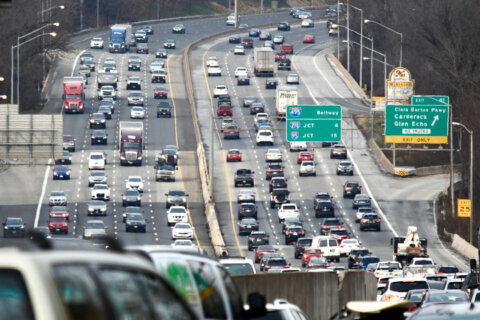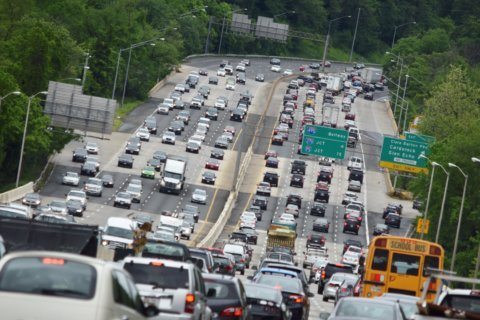WASHINGTON — State transportation leaders are shedding some light on the details of a deal that Virginia signed Thursday with private companies to finance, design, build, operate and maintain new toll lanes along Interstate 66 outside the Capital Beltway.
While what’s known as “commercial close” is happening Thursday, the financial part of the deal, including some negotiations over how much the companies and the state could save based on design revisions that make the project cheaper, is not expected to close until July.
The new lanes — two in each direction — will run from Gainesville to the Beltway and will feature dynamic tolling like what’s in place on the 95 and 495 express lanes.
Why no published toll rate?
A big question from drivers and opponents of the tolls, is often about what the actual toll rates will be.
“There is no published toll,” said Virginia Transportation Secretary Aubrey Layne. “What we’re saying is that it’s the same thing on 95.”
Layne said officials are not “hiding” from the public what the toll prices will be.
The tolls will fluctuate based on the number of cars using the lanes, with the goal of keeping traffic moving at 55 mph at a minimum.
“Dynamically priced tolls are going to generate the same toll because it’s a managing of the traffic,” regardless of who manages them, Layne said.
However, the public will not get to see the way that the private companies set the tolls.
“That is the only proprietary part of this whole process is their algorithm, and we have the ability to look and monitor through this to make sure that they are maintaining it based on the lowest toll necessary to maintain 55 mph,” Layne said.
In response to critics who complain that driving the full length of the lanes both ways every day would be too expensive for solo drivers, Layne emphasized that drivers have the choice to stay in the regular lanes, take commuter buses or carpool to avoid paying a toll.
When will more details come out?
Some construction and other details may not be available until the financial part of the deal closes in July, Layne said.
That is because the state and the private companies may still need to negotiate how much the state will save and how much the companies will save for design changes that make construction cheaper.
“Both teams came up with some incredible ideas. They could be things regarding maintenance and operations, but a lot of them were really about how you build this thing,” said Virginia Department of Transportation Commissioner Charlie Kilpatrick.
Some of the changes from the baseline contract released by the state this summer include changes that avoid costly disruptions to Metro power systems, new interchange designs, and the companies choosing to perform their own snow and ice removal in the express lanes rather than relying on the state.
“They brought some very, very cool alternative technical concepts that were real money,” Layne said.
Kilpatrick said some early work on design and other aspects of the project will begin soon using a loan from the state that will be repaid next year when the financial agreement is finalized.
“As you might imagine, if you’ve closed on a house it takes a couple months. Closing on something like this takes a little bit longer,” Kilpatrick said.
Why did these companies pay up?
Virginia received two bids for the project after a third entity pulled out. The winning bid includes no direct state contribution to the project and a $500 million payment to the state from the winning companies.
The Spanish-led Express Mobility Partners beat out a group that included Transurban, the Australia-based company that operates the 95 and 495 express lanes.
Virginia required that the deal include $800 million in transit funding and later corridor improvements, which come on top of the $500 million payment.
“Here’s one thing you never know unless you have a true competition: you never know why a third party makes an offer,” Layne told the Commonwealth Transportation Board. He said interest rates, taxes, market share and other factors can all play into the motivations for bidders.
Layne also acknowledged that the state’s last-minute move to allow big rigs to use the lanes — as long as the lane designs meet basic noise and safety requirements — added significant value to the deal for the companies.
Why tolls at all?
Many opponents of the toll lanes argue the state should simply build more regular lanes.
“Without tolling, we can’t do it,” Layne said. “Limited resources have consequences. So the question isn’t do something else. The question is either do this or to accept the current.”
Studies supporting the project found that the toll lanes could move more people than regular lanes through the incentives for carpooling or taking a bus to avoid the tolls.
Are the other Express Lanes around here working?
About a third of vehicles using the 95 Express Lanes travel free because they have three or more people inside, said Virginia Deputy Transportation Secretary Nick Donohue.
That is about twice the rate of HOV traffic using the 495 Express Lanes on the Capital Beltway. He expects HOV use on I-66 will fall somewhere between the two.
Eighty-five percent of toll-payers pay for five or fewer trips per month to use the 95 Express Lanes.
“This idea that every day, people are hopping on the 95 Express Lanes and they’re being forced to pay a toll that’s dynamic is inaccurate,” Donohue said.
Various studies supporting the construction of the lanes suggest that adding lanes and pushing people to carpool or to take commuter buses will lead to shorter commutes for those in the regular lanes too, but that’s compared to the bigger traffic mess that would result if no changes were made to I-66.
“If you’re heading eastbound in the morning, and you travel the entire 22 miles, in the future, with no improvements … we anticipate it would take you 90 minutes to travel those 22 miles. With these improvements, that goes down by 37 minutes. And that’s if you’re in the general purpose lane paying nothing,” Donohue said.
“If you were to head westbound in the evening, all the way from the Beltway to the end of this project, with no improvement in the future … it would take 66 minutes with no improvement. That would drop by 22 minutes each afternoon even if you’re in the general purpose lanes and paying nothing,” he said.







